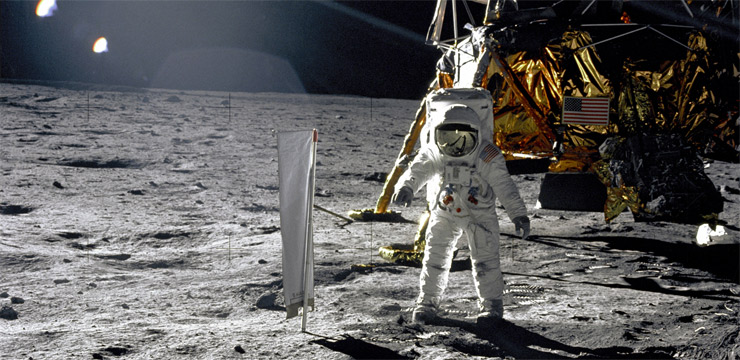
40th Anniversary of the Apollo 11 Moon Landing
July 2009 :
Movies have often provided us with many unforgettable lines. Who can forget, “I’ll be back.” Or how about, “You’re gonna need a bigger boat!” My favorite is, “Gentlemen, you can't fight in here! This is the War Room.” And perhaps more appropriate to astronomy and space science, “Klaatu. Barada, Nikto.”
While some of these lines may not be known to all the peoples of the world, reality often provides us with memorable phrases that will not soon be forgotten. This month, we celebrate the 40th anniversary of mankind’s greatest achievement when these words were spoken: “That’s one small step for (a) man. One giant leap for mankind.”
The date was July 20, 1969, and Neil Armstrong had just stepped off the ladder of the Eagle (the name for his LEM - Lunar Excursion Module) and set foot upon the lunar surface. He was shortly followed by Buzz Aldrin. Six more missions ensued. Apollo 13 astronauts never made it to the lunar surface after their near fatal accident, but Apollo 12, 14, 15, 16 and 17 brought ten additional moonwalkers to our desolate neighbor.
Many people remember the first two moonwalkers, but the other ten are a challenge to most. And when I ask if anyone remembers who was the third astronaut who remained in the command module circling the Moon, I sometimes encounter a quizzical look and the question, “There was a third?” I have to admit that as I prepared this brief tribute to the 40th anniversary of the Apollo 11 Moon landing, I too was unable to name all the command module pilots. In fact, I only got three out of seven.
So as we celebrate this crowning achievement of the US space program, we honor not only all the people who worked so hard on the Mercury, Gemini and Apollo missions, but also all the astronauts who paved the way for the Apollo 11-17 crews who had a rendezvous with destiny on the lunar surface.
Here is a table of the Apollo 11 through 17 crews (July 1969 – December 1972). The third named astronaut for each mission is the Command Module Pilot who remained in orbit about the Moon as the others descended to the surface. See how many of the moonwalkers you can name before you review the list.
- Apollo 11: Neil Armstrong Buzz Aldrin Michael Collins
- Apollo 12: Pete Conrad Alan Bean Dick Gordon
- Apollo 13:(moon landing aborted) Jim Lovell, Fred Haise, Jack Swigert
- Apollo 14: Alan Shepard, Edgar Mitchell, Stuart Roosa
- Apollo 15: David Scott, James Irwin, Al Worden
- Apollo 16: John W. Young, Charles Duke, Ken Mattingly
- Apollo 17: Gene Cernan, Harrison Schmitt, Ronald Evans
I am pleased to note I have had the distinct honor of meeting two of the above astronauts: Jim Lovell and David Scott.
The Moon is often a target for our telescopes at Seagrave Observatory when we are conducting an observing program for a scout or school group. These youngsters weren’t even born when the last man walked on the Moon – Gene Cernan. Invariably we get the question, “Can the telescope show anything left behind by the astronauts on the Moon’s surface?” The short answer is no, but this usually starts a discussion of the Apollo missions.
You know you are getting old when someone in the group pipes up and states, “Oh, we learned about that in history class!!”
Related Topics




